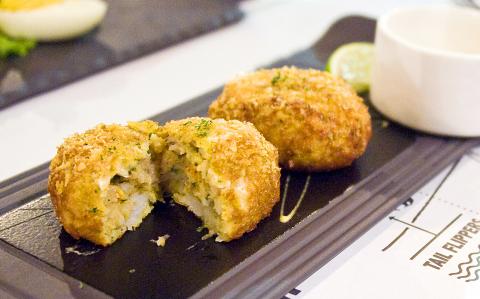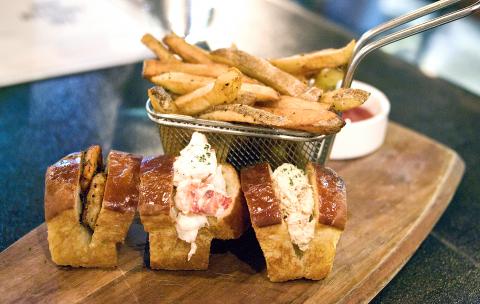From time to time, I still think of that amazing lobster roll I had at Ed’s Lobster Bar by the New York City waterfront on my last visit.
So I was pleasantly surprised when I passed by the Lobster Bar in Taipei. However, the restaurant’s higher-end, atmospheric interior, had always deterred me from just popping in for a quick seafood fix.
Eventually, I brought a date. But as soon as we sat down it became apparent that, due to portions and pricing, we should have brought a group so that we could sample the restaurant’s intriguing and diverse menu, which includes far more than its namesake suggests. For example, we didn’t order the seafood paella because there was a minimum order of two portions (NT$420 per portion), and who wants to fill up on rice when there’s lobster?

Photo: Han Cheung, Taipei Times
Also, visit early if you want to try the surf and turf burger (NT$680), featuring prime shoulder meat, foie gras and lobster. Alas, they only make 10 of these per day.
For appetizers, we ordered the deviled eggs (NT$280) and the crab cakes (NT$380 for two). The crab cakes were excellent, as each bite contained copious amounts of juicy crab meat with little filler. The abundance of meat, though, caused the bottom of the crab cake to become slightly soggy — but I’m not complaining. They were flavorful yet not greasy, and I didn’t need the lemon or tartar sauce that it was served with.
The deviled eggs were tart and rich, with faint sweet bacon highlights from the slivers on top. This appetizer would be better shared in a group, as with four eggs per order, the savoriness became overwhelming after the first two halves.

Photo: Han Cheung, Taipei Times
Since we had been talking about sandwiches, the mini rolls (NT$380 for three) were an obvious choice. The bite-sized rolls form all three of the restaurant’s signature seafood: lobster, crab and shrimp. This is where this restaurant really shines.
The generously-portioned lobster salad with a slight dollop of mayo was served in a soft roll and was a harmonious match that melted in my mouth. The crab roll was also in salad form, but with less mayo and not as sweet. The crab didn’t come in chunks like the lobster, constituting a finer texture. With this sandwich, the bread had a firmer texture, making an enjoyable contrast from the previous roll.
The shrimp roll was saltier, which balanced out the other two rolls. This one was my least favorite, as the shrimp was grilled and a bit chewy.
Since we were at a lobster restaurant, we splurged and ordered another entree. This was a mistake. Although filled with the sweet crustacean, the lobster ravioli (NT$620) in lobster sauce somehow felt more like a Chinese wonton than its Italian counterpart. The pasta was unevenly cooked — too firm in some places, overly soft in others and it fell apart quite easily.
The lobster sauce had appealing nutty overtones, but erred on the salty side and, like the noodles, carried more of an Asian than Italian consistency. Abundant garlic slices provided a kick, but as a whole it overpowered the main ingredient.
Later, I surfed the Internet to see what others were saying about Lobster Bar and the anecdotal consensus is that the uni pasta (NT$520) or duck truffle risotto (NT$480) would be a better entree choice despite their lack of, ah, lobster.
Although we didn’t try any alcohol, the menu has a small selection of beers, including the green tea-infused Iki and Hitachino Nest. It also features standard classic cocktails, hot cocktails as well as originals such as Alice in Lobsterland (NT$400, mango puree, cream, eggnog, soda water).
When I left, I wish I had just stuck to what I originally craved. Next time I come, I’m just going to sit by the bar and order a full-sized lobster roll with a beer.

April 14 to April 20 In March 1947, Sising Katadrepan urged the government to drop the “high mountain people” (高山族) designation for Indigenous Taiwanese and refer to them as “Taiwan people” (台灣族). He considered the term derogatory, arguing that it made them sound like animals. The Taiwan Provincial Government agreed to stop using the term, stating that Indigenous Taiwanese suffered all sorts of discrimination and oppression under the Japanese and were forced to live in the mountains as outsiders to society. Now, under the new regime, they would be seen as equals, thus they should be henceforth

Last week, the the National Immigration Agency (NIA) told the legislature that more than 10,000 naturalized Taiwanese citizens from the People’s Republic of China (PRC) risked having their citizenship revoked if they failed to provide proof that they had renounced their Chinese household registration within the next three months. Renunciation is required under the Act Governing Relations Between the People of the Taiwan Area and the Mainland Area (臺灣地區與大陸地區人民關係條例), as amended in 2004, though it was only a legal requirement after 2000. Prior to that, it had been only an administrative requirement since the Nationality Act (國籍法) was established in

Three big changes have transformed the landscape of Taiwan’s local patronage factions: Increasing Democratic Progressive Party (DPP) involvement, rising new factions and the Chinese Nationalist Party’s (KMT) significantly weakened control. GREEN FACTIONS It is said that “south of the Zhuoshui River (濁水溪), there is no blue-green divide,” meaning that from Yunlin County south there is no difference between KMT and DPP politicians. This is not always true, but there is more than a grain of truth to it. Traditionally, DPP factions are viewed as national entities, with their primary function to secure plum positions in the party and government. This is not unusual

US President Donald Trump’s bid to take back control of the Panama Canal has put his counterpart Jose Raul Mulino in a difficult position and revived fears in the Central American country that US military bases will return. After Trump vowed to reclaim the interoceanic waterway from Chinese influence, US Defense Secretary Pete Hegseth signed an agreement with the Mulino administration last week for the US to deploy troops in areas adjacent to the canal. For more than two decades, after handing over control of the strategically vital waterway to Panama in 1999 and dismantling the bases that protected it, Washington has